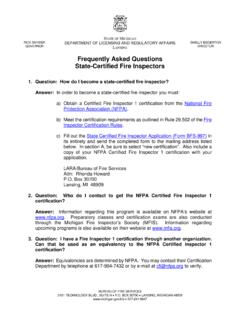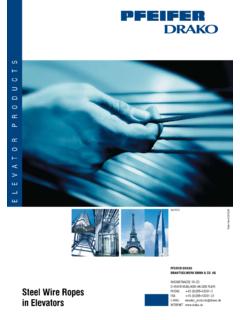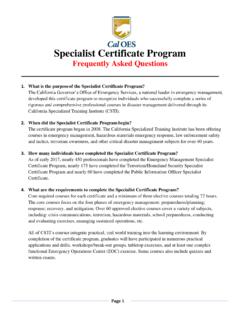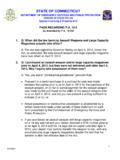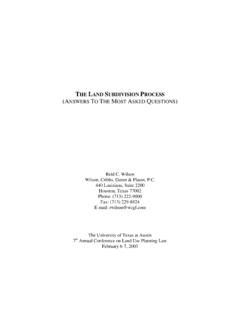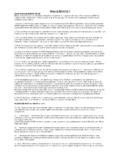Transcription of LEAD IN DRINKING WATER FREQUENTLY ASKED QUESTIONS
1 1 LEAD IN DRINKING WATER FREQUENTLY ASKED QUESTIONS Does the Northern Kentucky WATER District have lead in its WATER ? You may have read about or watched recent stories in the news about lead in DRINKING WATER , and we want to provide you with information about our system. The Northern Kentucky WATER District (NKWD) takes concerns about lead seriously. We test the finished WATER leaving the treatment plants. Finished WATER does not contain lead when it leaves the NKWD s treatment plants. The potential for lead in DRINKING WATER is primarily from possible leaching from your home plumbing ( , indoor pipes, soldered joints, and fixtures) and service lines (the pipe connecting your home to the WATER main). How is lead in DRINKING WATER regulated? The EPA published a regulation in 1991 to control lead in DRINKING WATER at customers taps.
2 Our monitoring and reporting is conducted in accordance with these regulatory requirements and guidance. The regulations include testing for lead in WATER samples collected from customers homes. The NKWD has been in continuous compliance with the lead standards. The most recent round of lead testing completed in 2015 showed there were no sites above the lead action level of 15 parts per billion. Please note, every home is different, so the amount of lead in your tap WATER may be lower or higher than the NKWD monitoring results for the selected sites. What is being done to control my exposure to lead? Protecting you against exposure to lead is a shared responsibility. The NKWD is required to provide treatment that minimizes the corrosivity of the WATER . We do this by adjusting the WATER s pH and by adding an inhibitor that protects materials against corrosion and leaching of lead into the WATER .
3 You can take responsibility for identifying and removing service materials within your home that may contain lead, including the service line going into your home, as an additional precaution. Who owns the service line going into my home? The service line is the small line that connects your home to the public WATER main. A portion of the service line is publically owned by NKWD and the remainder is privately owned. The portion of the service line between the WATER main and the point of service is the responsibility of NKWD. The point of service is the meter when the meter is located outside. For meters found inside the home, the point of service is the curb stop or the property line if no curb stop is present. The property owner is responsible for the private portion from the point of service to the home. How many lead service lines exist in Northern Kentucky?
4 The NKWD is the merger of 18 former entities over 80 years. We did not receive complete records on the WATER systems we inherited, including the service line materials. Because the service lines are buried, it is not possible to know exactly what types of materials are in the service lines without digging holes, which could potentially be in pavement and on private property. Based on observations from field work in our system and PVA building age information, we suspect that lead service lines are predominantly found in the older river communities in Campbell County and Kenton County, north of the Interstate 275 loop. 2 Structures built prior to 1930 have the greatest potential for having a lead service line. We estimate there are about 17,000 customers, or roughly 20% of the total number of customers, with structures meeting this criteria.
5 We believe that using lead for service lines was phased out over two to three decades. We are including structures built through 1955 in our upper estimate of 25,000 potential lead service lines, which is about 30% of the total number of customers. The upper range of our estimate is intended to be conservative so as to over-estimate rather than under-estimate. It is possible that homes built before 1955 do not have lead service lines. It is also possible that homes built after this date could have lead service lines. We don t know where every lead service line is located. Will the WATER utility replace my lead service line? Privately owned lead services lines on a customer s property are not part of the public WATER system, and it is beyond our authority or financial ability to replace pipes on a homeowner s property. Lead service lines, indoor plumbing and fixtures are owned and installed at the expense of the property owner.
6 The Northern Kentucky WATER District advises that you contact a licensed plumber for work on your service line and indoor plumbing. Service line replacement can cost individual homeowners an estimated $1,500 to $7,000. If you decide to replace your service line, which you are strongly encouraged to do, please contact our office at (859) 578-9898. We will want to review the type of service line material to document the private line replacement and possibly coordinate it with any public line replacement. I m concerned my home may have lead plumbing. How can I find out? Plumbing inside the home, such as lead pipes and copper pipes with lead-based solder and faucets with internal components having lead, are also a potential source of lead in WATER . If you re concerned your home plumbing may contain lead pipes, try scratching the pipe with a house key or screwdriver.
7 Lead pipe is a dull gray color that is soft enough to be easily scratched with a house key, but the scratch marks will appear bright silver. You may want to have your WATER tested by a state-certified laboratory. Testing is the only way to confirm if lead is present or absent. For more information on testing your WATER , including the availability for a free test, you can call the Northern Kentucky WATER District s laboratory at (859) 441-0482. How can I reduce my exposure to lead in my DRINKING WATER ? If you have lead service lines or as part of your internal plumbing, there are many steps you can take to reduce your potential exposure to lead in DRINKING WATER . If you have a lead service line, one step is to have the privately owned section replaced. Additional steps include: Run your WATER to flush out potential lead. If it hasn t been used for several hours, run the WATER for three to five minutes to clear the WATER that has been sitting in the lines.
8 Always use cold WATER for DRINKING , cooking, and preparing baby formula. Never cook with or drink WATER from the hot WATER tap as hot WATER can increase the potential for lead leaching from the pipes, solder, and fixtures. Never use WATER from the hot WATER tap to make infant formula. Take measures to ensure that children don t drink bath WATER . Do not boil WATER to remove lead. Boiling WATER will not reduce lead. Periodically remove and clean the faucet screen/aerator. While removed, run the WATER to eliminate debris. 3 You may consider investing in a home WATER treatment device. When purchasing a WATER treatment device, make sure it is certified under NSF/ANSI 53 to remove lead. Search for certified products at NSF International (800) 673-6275 or visiting or WATER Quality Association (630) 505-0160 or visiting Identify and replace plumbing fixtures containing lead.
9 Brass faucets, fittings and valves may leach lead into DRINKING WATER . Products sold after Jan. 4, 2014, must by law contain very low levels of lead. Have a licensed electrician check your wiring. Your home electrical system may be attached to your service line or elsewhere in your plumbing. If this connection is electrified, it can accelerate corrosion. Check with a licensed electrician to correct ground faults and evaluate your local electric code to determine if your wiring can be grounded elsewhere. DO NOT attempt to change the wiring yourself because improper bonding or grounding can cause electrical shock and fire hazards. What are we doing to enhance our lead control program? The NKWD is expanding its educational information and customer communication on issues related to lead. This involves notices for construction and maintenance work that may potentially involve repair or replacement of publically owned lead service lines.
10 While funding assistance for replacement of lead service lines is currently not in place at a local, state, or federal level, the NKWD will monitor the introduction of funding assistance, including for the privately owned portion, that may be made available in the future. What if I receive notice of WATER main construction or lead service line work? If you receive a notice regarding service lines in the course of capital projects or maintenance work and you determine your private service line is made of lead, we strongly encourage you to replace your privately owned lead service line as well. Please contact us at (859) 578-9898 to coordinate full lead service line replacement. Available research indicates that when lead service lines are disturbed, the amount of lead found in customers DRINKING WATER may increase for a period of time.
